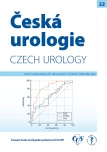Robotic extended pelvic lymphadenectomy in a patient with a biochemical recurrence of prostate cancer
Authors:
Milan Čermák 1; Eva Hoření 1; František Chmelík 1; Jiří Heráček 1,2; Jiří Kočárek 1,2
Authors‘ workplace:
Urologické oddělení, ÚVN - VFN, Praha
1; Urologická klinika, 1. LF UK a VFN, Praha
2
Published in:
Ces Urol 2018; 22(1): 11-13
Category:
Video
Overview
Introduction:
Prostate cancer is the most common oncological disease in the male population. The incidence of prostate cancer has increased dramatically over the last 20 years. Radical prostatectomy is the surgical method of first choice for the treatment of localized prostate cancer. This operation method is complemented with bilateral pelvic lymphadenectomy in patients with intermediate and high-risk tumors.
Description of the clinical case:
We present a case report of a 74-year-old patient with bioptically verified prostate cancer cT2b Nx Mx GS 3 + 3 iPSA 15.6 ng/ml PS 4/10, who underwent robotic bilateral nerve-sparing radical prostatectomy at our department in January 2014. According to the Partin and Briganti nomogram and EAU recommendations, pelvic lymphadenectomy wasn´t indicated. Preoperative findings showed the risk of lymph nodes involvement was less than 5%, so there was no indication to perform CT pelvic staging for intermediate tumors. Histopathological analysis of the surgical specimen showed prostate adenocarcinoma pT3b GS 4 + 4 R1 (1 x 1 mm – left seminal vesicle). After the operation the patient was fully continent, erection EHC grade 3 was achieved with the intracavernosal injection of 15 μg alprostadil. Post-operatively PSA was determined according to the recommended EAU procedures and its values did not exceed 0.05 ng/ml. In September 2016 there was a sudden elevation of PSA to 2.1 ng/ml, a month later the PSA increased to 2.5 ng/ ml. Subsequently a 18-F fluoro-choline PET/CT scan was performed with the finding of a 16 x 7 mm solitary lymph node with markedly increased radiopharmaceutical accumulation in the pelvis near the right external iliac bundle. Therefore in January 2017, after a decision by a multidisciplinary team, a bilateral pelvic lymphadenectomy using a robot-assisted approach was performed.
During the operation we have extracted the lipolymphatic tissue around the external iliac artery, obturator nerve, the internal iliac arteries and from the presacral area. The operation lasted for 180 minutes and blood loss was 150 ml. The drains were removed on the 2nd and 4th postoperative day. The patient was discharged home on the 7th postoperative day and the sutures were removed 10 days after the surgery. Histopathologically, 18 lymph nodes in the extracted samples were found. Two lymph nodes contained prostate carcinoma metastasis. One of those lymph nodes that were extracted from the right side had the size of 24 mm, and the other one that was extracted from the left side had microscopic metastasis. Two months after the surgery PSA level was 0.248 ng/ml. If PSA increases in future, we plan salvage radiotherapy.
Conclusion:
Robotic extended bilateral pelvic lymphadenectomy is a mini invasive, safe, technically feasible and effective treatment method for patients with a biochemical recurrence of prostate cancer and detected lymphadenopathy in the regional lymph nodes on diagnostic imaging methods. Nevertheless, due to the elimination of surgeon‘s hands tremors, the instrument´s seven degrees of movement, the high image resolution, the magnification of the operating field, the possibility of handling three surgical instruments and camera simultaneously, allows the surgeon to perform a faster and more accurate operation with a subsequent faster patient recovery.
Key words:
Lymphadenectomy, prostate cancer, radical prostatectomy, robotic surgery.
Sources
1. Kočárek J, Heráček J, Čermák M, Chmelík F, Matějková M. Roboticky asistovaná radikální prostatektomie – výsledky u 1 500 operací. Rozhledy v Chirurgii 2017; 92(2): 75–81.
2. Hora M, Babjuk M, Broďák M, et al. Stěžejní urologické operační výkony v urologii v ČR v letech 2009–2014. Ces Urol 2016; 20: 135–140.
3. Feicke A, Baumgartner M, Talimi S, et al. Robotic‑assisted laparoscopic extended pelvic lymph node dissection for prostate cancer: surgical technique and experience with the first 99 cases. Eur Urol 2009;
55: 876−884.
4. Doležel J, Tvarůžek J, Staník M, et al. Časné zkušenosti s roboticky asistovanou laparoskopickou radikální prostatektomií – prvních 153 pacientů. Ces Urol 2009; 13: 168–77.
5. Broďák M, Košina J, Balík M, et al. Robotem asistovaná radikální prostatektomie, zkušenosti po provedení prvních 50 operací. Urol. praxi 2017; 18(3): 129–132.
Labels
Paediatric urologist Nephrology UrologyArticle was published in
Czech Urology

2018 Issue 1
Most read in this issue
- (-2)proPSA and Prostate Health Index (PHI) in predicting the presence of prostate cancer in transrectal biopsies
- A large rectus sheath haematoma spreading to Retzius’ space (chronic antithrombotic therapy) followed by acute kidney injury caused by urinary bladder compression with its spontaneous perforation
- The issue of prostate cancer screening
- The value of ultrasound evaluation in predicting high-grade vesicoureteral reflux in children under two years of age
